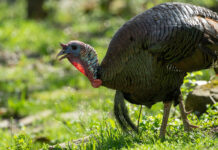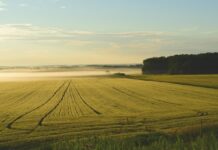Throughout the springtime, there are many opportunities to discuss ways to improve pasture management in the field with farmers. For me, with the landscape fresh, green and full of new life, there is no better place to be than out in the pasture and it is the perfect place for a consultation. Springtime forage management concerns typically start with when to turn in animals out to graze followed by how long to let them graze.
Although the physiological processes of plant growth that lead to the spring flush of forage are complex, there are simplified guides for when to graze and when to stop. All of the guides are user dependent, require repetition and are subject to human error, but with a series of simple steps and a little investment of time, you can create a seasonal grazing plan without low monetary investment.
Let’s explore how to make pasture measurement worth it.
Envision the layout of your farm. This could be from an aerial photo, a map or a drawing. Make it accessible in a way that you can visualize pasture divisions, water sources and access points. Label your large pastures by a recognizable name. Then consider if those pastures can be divided into smaller sections aka paddocks. If so, label those paddocks as well. Then, it is time to start measuring.
Estimate
One of the simplest methods for measuring and estimating forage availability is using a grazing stick. A grazing stick combines information about forage height, forage density, species of forages growing in the pasture and residual grazing heights into a tool that looks like a yard stick. By combining this information, the pasture manager can determine an estimate of available forage dry matter per grazing paddock. With additional information about animal intake, the manager can also calculate an estimate of how many days the paddock could be grazed before rotating to a new area.
Grazing sticks are often available and distributed at events hosted by land grant universities, soil and ater conservation districts, forage and grassland councils, state agriculture departments, the USDA Natural Resource Conservation Service, fairs, conferences and more.
Most states have their own customized version. There are grazing sticks designed for cool-season forage stands and warm-season forage stands. Most of the grazing sticks available in Ohio are for cool-season grasses. If you can’t wait for an event to secure one, you can find them online for sale.
A video of how to use a grazing stick can be viewed at go.osu.edu/grazingstickhowto
Step-by-step instructions with examples are available on the OSU Beef Team webpage at: https://u.osu.edu/beef/2024/03/27/how-to-use-a-grazing-stick/.
Get specific
For more accurate estimates of forage availability, you can clip samples from the pasture, weigh them with a scale, dry them in a microwave oven or an air fryer, weigh them again and determine dry matter estimates per acre. Protocols for forage drying are available for reference at go.osu.edu/determineforagemoisture.
Create or use a frame of known area. Using a 2-foot-by-2-foot square is one common way. You could also use a hula hoop and calculate the area of a circle. Then, use this frame as a standard unit of measurement. You will also need a paper bag and sharp shears.
Go out in the pasture and lay your frame on the ground. Clip, gather and bag all the forage within the frame down to the height where you want animals to stop grazing. This is your forage sample. Weigh the sample (factoring out the weight of the bag) and note this as the “wet weight,” and proceed to dry the sample with your preferred method. Once there is no detectable change in weight, you can consider the sample dry and weigh it again. Note this as the “dry weight.” Take the dry weight number divided by the wet weight number to determine the dry matter percentage. Repeat this for all of your samples to determine the average dry matter percentage across the pasture and use your standard unit of area (your frame) to scale up the amount of dry matter available per acre.
This method of measurement takes a lot of time and patience..
Rising plate meter
The pasture manager looking for accuracy, ease and speed should consider the rising plate meter. Rising plate meters are specialized tools that are calibrated to measure forage mass on a dry matter basis with a field walk and mathematical equation to determine available forage. Because these tools are specially calibrated for this purpose and typically shipped from New Zealand, they do have a heftier price tag. A brand new standard model with manual calculation features will run about $600 and fancier models with USB or Bluetooth capabilities and built in calculations can go up to about $1,400.
Many wonder if the tool is worth the cost. My hunch is that your profit increase in pounds of meat and milk per acre in a grazed system will quickly pay for the initial plate meter purchase if you are willing to use it.
The grazing stick, clipped samples and the rising plate meter won’t help you if they spend the grazing season in a corner of the barn or a closet. They depend on the pasture manager to get out into the field and observe the pasture. Of course, as technology advances, there are more methods emerging for monitoring pasture growth and forage availability. Just like the methods presented in this article, those require effort and repetition throughout the season for accurate estimates of pasture productivity.
For assistance determine if measuring pasture availability would be beneficial to your operation, reach out to your local Extension Office, SWCD or NRCS for consultation.













